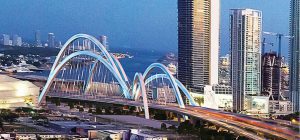|
Getting your Trinity Audio player ready...
|

(Florida Department of Transportation)
To the Editor:
If you’ve driven through Miami’s traffic-choked Midtown motorways, you’ve probably noticed and scowled at the massive development closing down several lanes and blighting our skyline. That project is “The Fountain,” a huge new bridge that will host an expanded segment of the I-395 over NE Second Avenue and Biscayne Boulevard.
The most prominent part of this overpass, which stakeholders are touting as a future Miami landmark, is its six fountain-like arches. These concrete structures span 1,025 feet across the bridge’s two roadways and intersect into a central point, symbolizing “Miami as a place where people from all backgrounds come together and live as a community,” according to a press release by the project’s developers.
This slick and symbolic design undoubtedly will make the bridge a landmark of Miami’s skyline, but it comes at a hefty price. To build the lane-expanding project that centers around this structure, the Florida Department of Transportation and Miami-Dade Expressway Authority have contracted the services of the Archer Western-de Moya Group Joint Venture for a jaw-dropping $840 million in taxpayer funds. These developers initially estimated that construction would end in 2024, but they’ve pushed this date back to late 2027. Still, you might say, if this project ends up clearing up our jammed roads, isn’t it worth it?
But it won’t reduce gridlock on Miami’s clogged expressways. While developers are promoting the roadway enlargements promised in this development — three new through lanes on the I-395 in each direction and new connector ramps — as a way to ease our city’s infuriating congestion, this isn’t the case. Road expansions actually don’t help decrease traffic in the long term.
This is because of induced demand, an economic term that describes when creating more supply of a good incentivizes greater use of it. In this case, more lanes simply incentivize more people to start driving, leaving the city in the same situation as before.
Think about this as a rational actor: if people use other modes of transportation than driving to get around (walking, biking, or carpooling, for example) because traffic is so bad, a lane expansion makes driving more viable and leads those people using substitutes to switch, keeping traffic the same as it was before the development.
This isn’t just theory. In 2009, two economists — Matthew Turner and Gilles Duranton — compared new road and highway infrastructure built in U.S. cities with driving rates over the same period. They found a “perfect one-to-one relationship” between new motorway development and the amount of driving. This means that adding more lanes doesn’t reduce traffic; it merely keeps it at the same level.
The problem isn’t a shortage of lanes. The problem is our overreliance on roads and other infrastructure that caters to inefficient and polluting automobiles. Investing more and more into car-based infrastructure doesn’t solve our transportation problems. It’s a colossal waste of money, and — most importantly — it fuels the flames of a climate crisis that we’re running out of time to fix.
As a city that’s disproportionately vulnerable to climate change, we can’t afford to increase the share of gas-guzzling motor vehicles on our roadways. We have to promote a rapid transition to renewable energy, and creating more space for combustion engines to emit greenhouse gases into our atmosphere is precisely the opposite of how to do that. But what’s the alternative?
To save our city (and our planet) from the ravages of a climate apocalypse, we must mobilize against the construction of new roads (and other polluting structures) and push for the widespread adoption of public transit.
In Paris, authorities have consistently downsized roadways in recent decades. As a result, many former drivers switched to public transport, with ridership increasing by 20 percent in the two decades from 1994 to 2014. Similarly, cities around our country have begun to push back against car-centric infrastructure to create more walkable, public transport-friendly, and cleaner cities, promoting sustainability and generating more opportunities for shared urban green spaces. The solution is clear: road expansions must be left in the past. Our future depends on it.
But as it functions today, Miami’s pathetic public transport system is not effective enough to move people around our city. If it received the investment it deserved (those $840 million that went to the bridge, for example), our metro might actually become a viable alternative to driving around. Those funds could go to more routes, bigger stations, and public transport across Biscayne Bay.
The problem is that our elected officials are too committed to gentrifying and commercializing our city, and the image of a glamorous and chic Miami doesn’t mesh well with the Metrorail.
Here’s the thing, though: these politicians are supposed to work for us. If you’re eligible to vote, find candidates that pledge to increase accessibility to public transportation. If you’re passionate enough, join a climate advocacy group like the Miami Climate Alliance or the CLEO Institute. You could even run for local positions that have a say in developments like this one.
As a city that will bear the brunt of climate change, we can’t be complacent as politicians pursue expensive and unsustainable projects. We must get involved and make those in power listen.
Jonathan Pollak
Born and raised in Miami, Jonathan Pollak is a student at Columbia University studying economics and political science.
ABOUT US:
For more Miami community news, look no further than Miami Community Newspapers. This Miami online group of newspapers covers a variety of topics about the local community and beyond. Miami’s Community Newspapers offers daily news, online resources, podcasts and other multimedia content to keep readers informed. With topics ranging from local news to community events, Miami’s Community Newspapers is the ideal source for staying up to date with the latest news and happenings in the area.
This family-owned media company publishes more than a dozen neighborhood publications, magazines, special sections on their websites, newsletters, as well as distributing them in print throughout Miami Dade County from Aventura, Sunny Isles Beach, Miami Beach, Coral Gables, Brickell, Coconut Grove, Pinecrest, South Miami, Kendall, Palmetto Bay, Cutler Bay and Homestead. Each online publication and print editions provide comprehensive coverage of local news, events, business updates, lifestyle features, and local initiatives within its respective community.
Additionally, the newspaper has exclusive Miami community podcasts, providing listeners with an in-depth look into Miami’s culture. Whether you’re looking for local Miami news, or podcasts, Miami’s Community Newspapers has you covered. For more information, be sure to check out: https://communitynewspapers.com.
If you have any questions, feel free to email Michael@communitynewspapers.com or Grant@communitynewspapers.com.





